Are you are a crazy seed saver?
You know the type: you have avocado pits sprouting on the counter, watermelon seeds drying on paper towels, lemon seedlings sprouting on the bathroom windowsill…
Life is full of temptations for seed savers. Every fruit has a pit… Every nature hike has a must-have wildflower… Every trip to a botanical garden, you’re keeping your hands stuffed in your pockets so they don’t “accidentally” pinch a cutting.
But then, fall arrives… and you completely lose it.
Farm stands are loaded with amazing produce containing seeds! Yes seeeeeeeds, precious seeds! The grocery store is stocking winter squash varieties you’ve never seen before. That nice Mennonite family down the road has some crazy birdhouse gourds in a shape you haven’t seen before. There is amazing Indian corn for sale on the roadside. And you’re all over it.
My personal favorite finds are the pumpkin and winter squash, and this is most definitely the season.
The other day I screeched to a halt in our car after passing a roadside stand sporting the craziest pumpkin I’d ever seen for sale. After realizing we weren’t all going to die in a fiery crash, my wife grinned at me and said, “pumpkin?” I nodded and ran before someone else could snag it.
She’s used to this seed-saving madness. I’ve been doing it for so long that if I ever stopped, she’d know I was taken over by an alien space pod.
But I digress.
Since Halloween is almost here and a lot of us will be cutting open pumpkins, let’s cover how to save pumpkin seeds. If you’d like to grow next year’s jack-o’-lanterns yourself or if you’re the type that can’t help but bring home beautiful new varieties from the local farmer’s market, today’s post is for you.
I’ve been growing pumpkin and winter squash for a long time and I’ve always loved how easy it is to save pumpkin seeds. They are a great size for planting and also germinate readily. Much more fun than dealing with mustard, lettuce, or carrot seeds.
Recently I posted a new video on how I save pumpkin seeds — and how I make seed packets to hold them until it’s time to plant them in the spring.
Here’s the video:
Now let’s break it down into a nice visual guide with pictures and everything.
How To Save Pumpkin Seeds, Step by Step
Are you ready to pack away seeds like a kleptomaniac squirrel so you never have to buy another pumpkin from the store again? I will help.
Step 1: Gut the Pumpkin and Save the Slop!
The inner cavity of pumpkin and winter squash is filled with a stringy mess of pumpkin bits and seeds. This isn’t the “good eating” part of the pumpkin, so it’s not worth trying to save any of the stringy mass, except for the seeds. In order to do that, move on to step two!
Step 2: Clean the Pumpkin Seeds
I dump pumpkin guts and seeds into a colander and swish them around under running water to clean them off, smashing the goop through the holes and separating the strings. If you’d like to save pumpkin seeds for eating rather than planting, you can just go directly to roasting them at this point.
For seed-saving purposes, I’ve sometimes let pumpkin guts sit on the counter for a few days and rot around the seeds. This smells bad but really loosens up the seeds when you wash them out. I think it may also increase the germination rate but I haven’t tried a side-by-side trial.
Step 3: Dry The Seeds
Seed-covered paper towels on counters, windowsills, shelves, tabletops, dressers and even the bathroom counter are common in our house during the fall as we save pumpkin seeds alongside the other heirlooms we want to plant in our spring gardens.
Spread your pumpkin seeds out someplace where they won’t get wet again. Also make sure they aren’t too wet when you spread them out (sometimes I pat them down with one paper towel, then spread them onto a second) and have good air circulation as you most definitely do not want them germinating on your counter. They should dry quickly. This will also keep them from molding as easily in storage and potentially losing their ability to germinate.
Step 4: Make Seed Packets and Pack ’em Up!
There are better ways to make seed packets, but I just rip a sheet of paper in half, fold that, then fold up the edges a few times and tape them. You can see how in the video – it’s very simple.
Because I’m cheap and hate throwing things away too fast, I use scrap paper from the children’s homeschool assignments or pieces the toddler has doodled upon.
My friend Steven Edholm has better looking seed packets, but they’re a bit small for the amount of pumpkin seeds I store.
I also illustrate my homemade seed packets, which is NOT OPTIONAL. You have to draw on them. You just have to. It’s the rule.
Along with a drawing of the mother pumpkin, I also note the variety, the harvest year and notes on type. This is important as I work on my pumpkin breeding projects, but for your pumpkin seed saving, you likely just need to note the type or draw a nice picture of the headless horseman.
If you live in a humid climate or need to store seeds for a longer period, you can dry pumpkin seeds a little further in a dehydrator and then pack them in tightly shut Mason jars stowed in the fridge.
That’s it, the whole scoop on how to save pumpkin seeds. Happy gardening and enjoy the rest of October.
(This is an updated version of a post that was originally published October 25, 2016.)
David The Good is a Grow Network Change Maker, a gardening expert, and the author of five books you can find on Amazon: Compost Everything: The Good Guide to Extreme Composting, Grow or Die: The Good Guide to Survival Gardening, Totally Crazy Easy Florida Gardening, Create Your Own Florida Food Forest, and Push the Zone: The Good Guide to Growing Tropical Plants Beyond the Tropics. Find fresh gardening inspiration at his website TheSurvivalGardener.com and be sure to follow his popular YouTube channel.
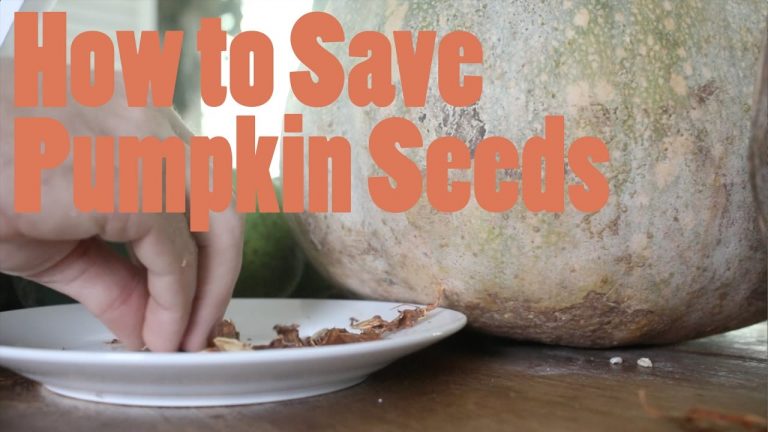
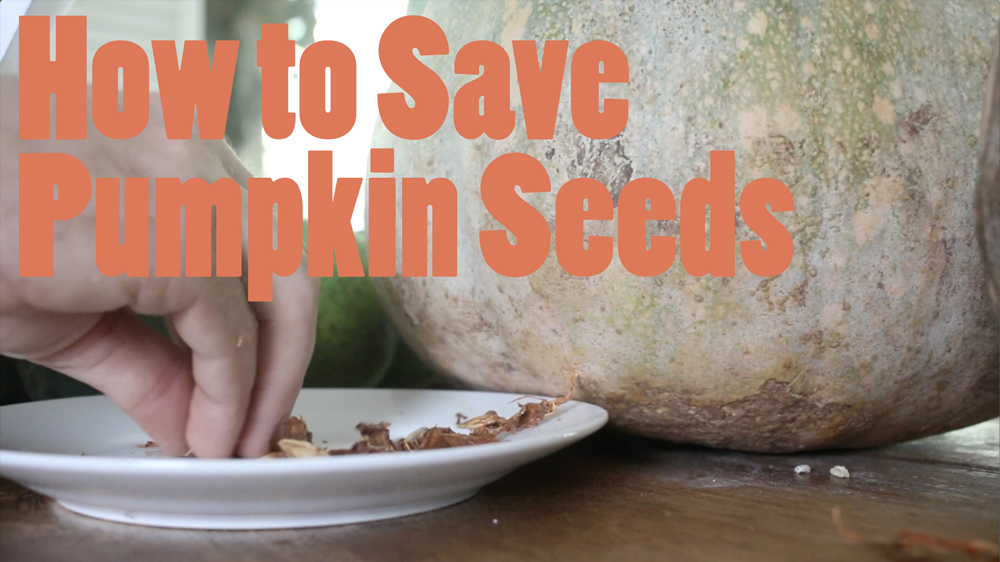
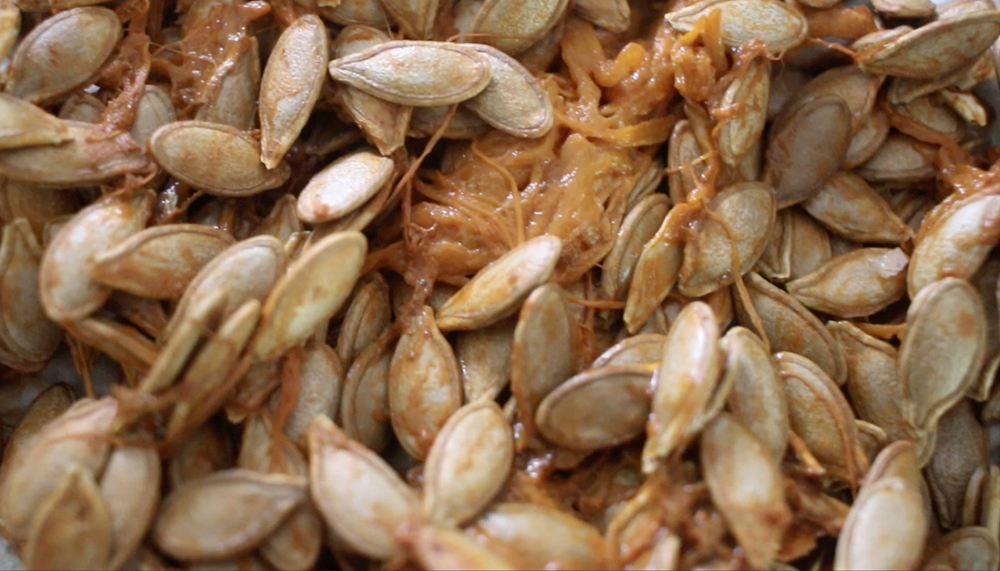
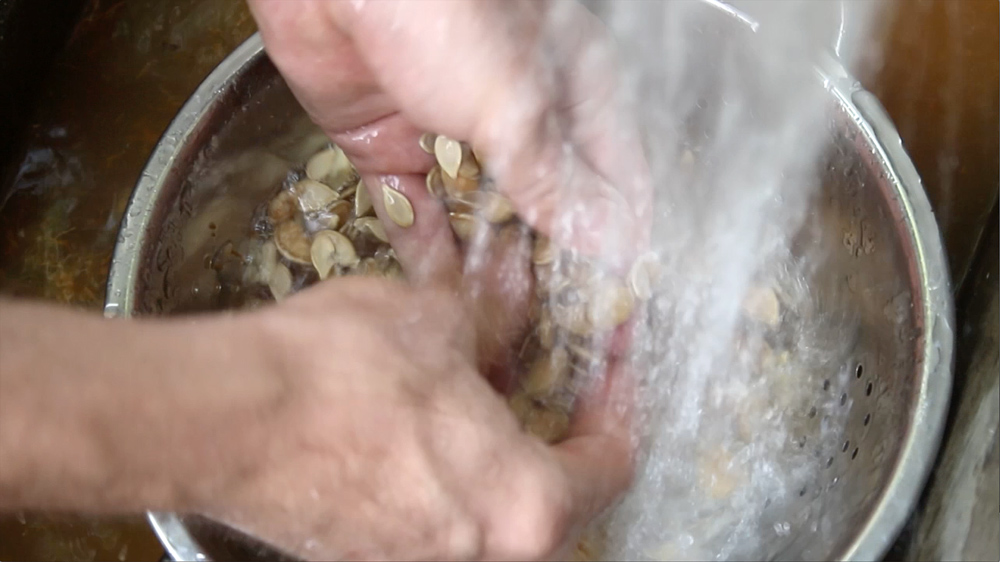
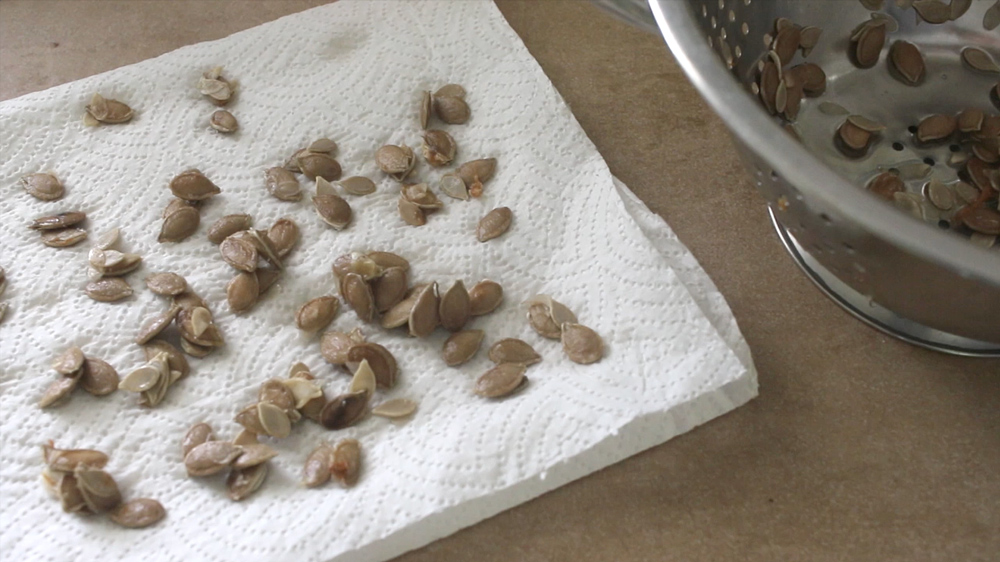
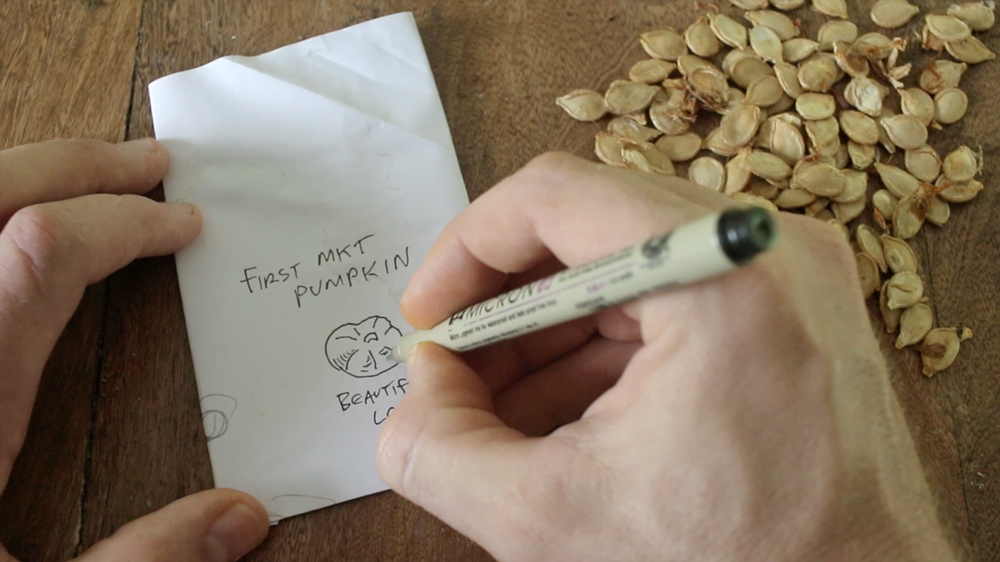
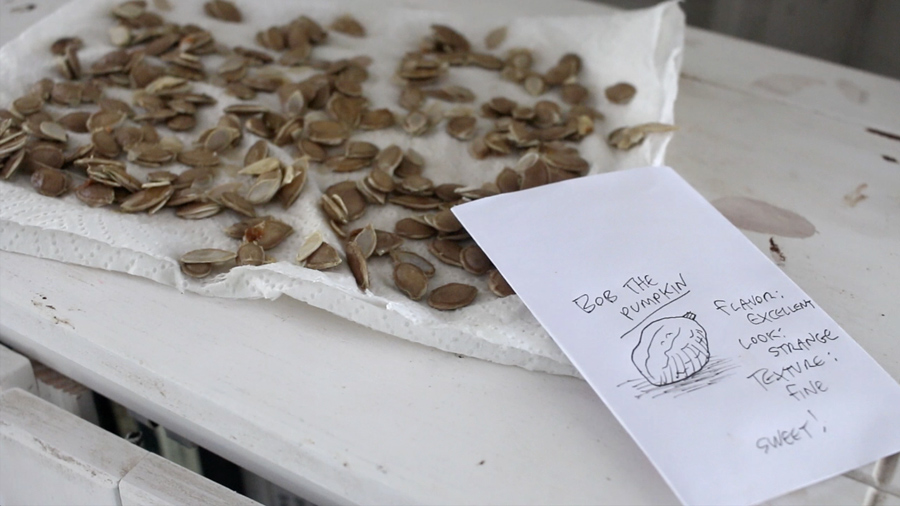








COMMENTS(27)
Awesome tutorial David! We do something similar, although this year our pumpkins did not fair so well. The weather was so up and down for us this season.
Yes – same here. We had some dry weather, followed by too much rain. Fortunately I was growing C. moshata varieties so this still produced. My C. maxima types gave up.
The lazy bugger that I am I use disposible tea bags as I have them lying around in my kitchen in bulk – I am what you might call a heavy user of loose tea and I simply don’t have the patience to fiddle about with the a cloth one even though that would be the enviromental choice. As I started by saying: lazy bugger. You can write on them, they don’t stay wet in case they come in contact with water unlike regular writing paper which will stay damp for a long time and best of all: the pocket is premade So you don’t have to fiddle with tape and folding. I keep my seeds on a box so they don’t see sunlight untill I take them out in spring. Something worth considering at least.
If you are going for most excellent contents like
myself, only pay a visit this website daily because it presents quality contents, thanks
You can also grind them up and put them in your dog or cat food to get rid of worms in your pets. Plus, they are filled with so many good vitamins for your pets.
Good idea!
Great article!Thank you.
I did this last year and they germinated very easy this year.
Lots of flowers too, only no pumpkins… 🙁
You have to make sure the pumpkin is not a hybrid. The organic heirloom would be the only ones worth fooling with. Roasting them is great but can be hard on the teeth. 🙂 so be careful. They are so nutritious.
It’s not likely a hybrid issue. Hybrids will make pumpkins – they are just variable in what you get. The way pumpkins work is they produce male blooms for a time, followed by female blooms. You might get 10-20 blooms incapable of producing a pumpkin before a female bloom arrives which is. If the plant declines and fails in that time period, no pumpkins. If female blooms are not pollinated, you’ll also fail to get pumpkins. Rain at the wrong time or a lack of pollinators can cause the latter.
LOL now I know why I have enjoyed reading this article so much … It’s good old David the Good, humor and all! Thanks mate, I’m currently reading your book ‘Grow or Die’ … Never found a read so captivating … Your writing style seriously competes with my Harry Potter craze LOL. Thanks so much 🙂
Thank you, Nadia.
How to get a lemon to hold bloom an gave lemon to grow
Thanks for the amusing and informative article!
I use empty junk mail envelopes to save my seeds– cut off the portion I need, that way part of the packet is already sealed for me 🙂
Happy Fall, y’all!
Perfect!
How come pumpkin seeds at the store are green but out of the pumpkin they are white?
That’s a great question, Dan. The seeds from inside a jack-o-lantern and most pumpkins and winter squash have shells. The green seeds from the store come from rarer varieties which have “naked” or “shell-less” seeds. This one, for instance: https://www.rareseeds.com/kakai-squash/
Some cultures selected and grew varieties with hull-less seeds and inferior flesh, preferring to save the seeds as a staple much like Europeans saved grain.
You might, also, mention that you can take the pumpkin seeds, bake them with sea salt on them and they are good eating.
Thank you for the video. You didn’t specify but I expect you rinsed in cold water. I take the time to separate the seeds from the goop before rinsing. You might not think it’s worth saving but I find it sweet and delicious right from the pumpkin, and I expect it’s also nutrient dense. (“The nearer the bone the sweeter the meat”?). Also I have a design for a paper seed packet that I think you would like that doesn’t use tape and was originally designed as a paper drinking cup, but am not sure how or where to send it. I probably have the technology to make a video like the one above but haven’t been able to integrate it yet. Can I send the details to Nikki at happiness?
Hold on! Mason Jars? I thought seeds needed at least a Little fresh air
No – they are fast asleep and keep fine in the fridge. In fact, the humidity in the air (at least in moist climates) hastens their decline. In Arizona, no problem.
I’d like to make just one more suggestion. I use an indelible marker to write the variety name on the paper the seeds sit to dry on. I *know* I won’t forget which squash seeds are which when I go back to package them (ha! ha!), but since I’ve started writing that down, it’s taken the stress and guess work out of seed drying.
That’s a great idea! I have lost count of how many times I was sure I would remember what I was drying, only to end up with a pile of what I call mystery seeds. The only thing I can do at that point is plant a few of them in an extra space somewhere to see what they turn into.
Loved this HOW TO!! simple and easy to understand!
I saved some nice winter squash seeds last year. The plants grew well, but I had a major infestation of squash bugs that ate them all. I used to make seed packets out of junk mail envelopes, but this year I am using one of those plastic organizer boxes that they sell for craft and sewing supplies. It is divided into eighteen sections, but they come in different sizes, and the lid snaps down tight so the seeds won’t fall out. I put a little piece of paper in each section with the information about the variety. I also try to not put similar looking seeds adjacent to one another—pumpkins will not go next to winter squash, but they are okay next to, for example, tomatoes or dill, in case I accidentally drop a seed or a few in the wrong section. Also, since the plastic doesn’t breathe, I have to make sure all of the seeds are thoroughly dry before putting them in the box.
Do I need to keep the seeds in the fridge if I’m in a dry climate? Or is just in packages in a cupoboard ok?
Wow! For a second I thought I was reading a description of myself in this article. I’m obsessed with saving seeds and growing things. My clementine tree grown from a seed in a store-bought clementine fruit is now 5 1/2 ft tall and my pineapple plant grown from a store-bought pineapple tuft is about 20 times the size it was at the store. I just can’t resist trying to grow stuff from seed or store-bought items. I make my seed packets the EXACT same way you do, though I’m usually collecting smaller seeds so I cut scrap paper up into smaller squares then do the folding/taping/labeling process. I’ve got an entire refrigerator drawer dedicated to all my seeds. I take empty seed packets with me when going to any botanical garden because I ALWAYS come home with a variety of new seeds to try.
Like the video and blog, but would add you also need to put a date on the seed packets.
When I’m in major seed saving mode I dry them on paper plates on which I write the variety name, and then can stack them after they are dry until I get them in packets. Since my local library has Seed Exchange Days I already have a convenient way to display and transport them on the paper plates.